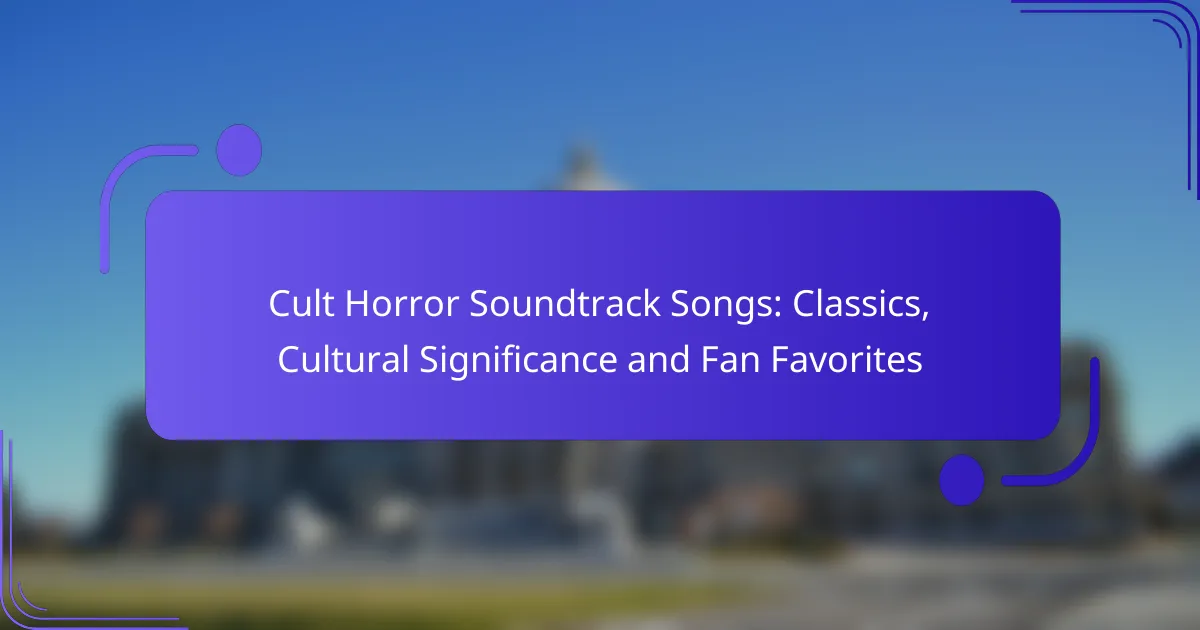Cult horror soundtrack songs play a crucial role in shaping the atmosphere and emotional depth of the films they accompany. These iconic tracks not only enhance the viewing experience but also resonate deeply with fans, influencing both the genre and popular culture. Their lasting impact is felt long after the credits roll, solidifying their status as cultural touchstones in the horror landscape.
![]()
You can explore more about these influential tracks on our homepage.
What Are the Most Iconic Cult Horror Soundtrack Songs?
The most iconic cult horror soundtrack songs are those that have become synonymous with the films they accompany, often enhancing the eerie atmosphere and emotional impact. These tracks are not only memorable but also hold significant cultural value, resonating with fans and influencing the genre.
“Tubular Bells” by Mike Oldfield
“Tubular Bells” is renowned for its haunting melodies, which became the defining theme for the film “The Exorcist.” The song’s gradual build-up creates a sense of unease, perfectly matching the film’s chilling narrative. Its influence extends beyond the movie, making it a staple in horror music playlists.
This composition features a unique blend of instruments, including piano and various percussion, which contribute to its distinctive sound. The track’s eerie tones and repetitive motifs evoke a sense of dread, making it a classic in the horror genre.
“Halloween Theme” by John Carpenter
The “Halloween Theme,” composed by John Carpenter, is instantly recognizable and has become a hallmark of horror music. Its minimalist piano riff, combined with a steady rhythm, creates an atmosphere of suspense and terror that perfectly complements the film’s narrative. This theme has been widely referenced and parodied in various media.
Carpenter’s use of simple yet effective musical elements demonstrates how less can be more in horror soundtracks. The repetitive nature of the theme builds tension, making it a powerful tool in the film’s storytelling.
“The Exorcist Theme” by Mike Oldfield
Also known as “Tubular Bells,” this theme is often referred to as “The Exorcist Theme” due to its association with the film. Its haunting soundscapes and gradual progression create an unsettling atmosphere that has left a lasting impact on audiences. The track’s eerie qualities have made it a favorite among horror enthusiasts.
Its cultural significance is evident, as it has been used in various contexts beyond the film, including commercials and other media, further cementing its status as a classic horror soundtrack.
“A Nightmare on Elm Street Theme” by Charles Bernstein
The “A Nightmare on Elm Street Theme” by Charles Bernstein is characterized by its unsettling synth sounds and rhythmic beats, which evoke a sense of danger and urgency. This theme effectively captures the essence of the film, immersing viewers in the nightmarish world of Freddy Krueger. Its distinctive sound has made it a memorable part of horror music history.
Bernstein’s composition utilizes dissonant chords and unexpected shifts, creating an atmosphere of unpredictability that mirrors the film’s plot. This theme remains a favorite among fans, often featured in horror playlists and events.
“Suspiria Theme” by Goblin
The “Suspiria Theme” by Goblin is a prime example of how music can enhance the visual experience of a film. Its blend of progressive rock and horror elements creates a surreal and haunting soundscape that perfectly complements Dario Argento’s film. The theme’s use of synthesizers and dramatic vocals adds to its unsettling quality.
This track stands out for its ability to evoke strong emotions, making it a favorite among horror fans. Goblin’s innovative approach to film scoring has influenced many contemporary composers in the genre, solidifying its place in cult horror music history.
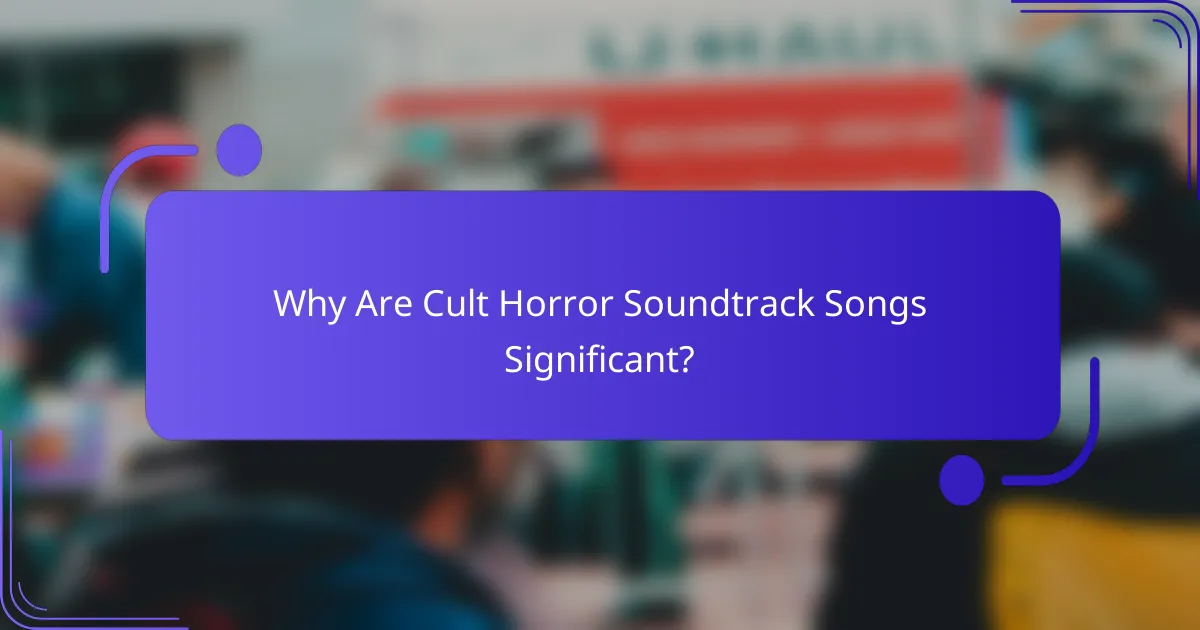
Why Are Cult Horror Soundtrack Songs Significant?
Cult horror soundtrack songs are significant because they enhance the emotional experience of the film, creating lasting impressions that resonate with audiences. These tracks often become iconic, influencing both the genre and the broader cultural landscape.
Cultural Impact on Horror Genre
The cultural impact of cult horror soundtrack songs is profound, as they often define the atmosphere and tone of their respective films. Iconic scores, such as those from “Halloween” or “The Exorcist,” have become synonymous with the horror genre, influencing countless filmmakers and composers.
These soundtracks not only contribute to the narrative but also shape audience expectations and experiences. The eerie melodies and unsettling soundscapes create a shared cultural language that horror fans recognize and appreciate.
Influence on Filmmaking Techniques
Cult horror soundtracks have significantly influenced filmmaking techniques, particularly in how sound is used to build tension and suspense. Filmmakers often rely on specific musical cues to elicit fear, guiding audience reactions and enhancing the storytelling process.
For example, the use of dissonant chords or sudden shifts in tempo can heighten moments of shock or dread. This approach has led to a greater emphasis on sound design in horror films, with many directors collaborating closely with composers to achieve the desired emotional impact.
Connection to Fan Communities
Cult horror soundtrack songs foster a strong connection among fan communities, often serving as a shared experience that brings people together. Fans frequently discuss and celebrate these soundtracks, creating a sense of belonging and nostalgia.
Events such as live orchestral performances of horror scores or vinyl record releases further solidify this bond. Fans often curate playlists featuring their favorite tracks, showcasing their passion and deep appreciation for the genre’s music.
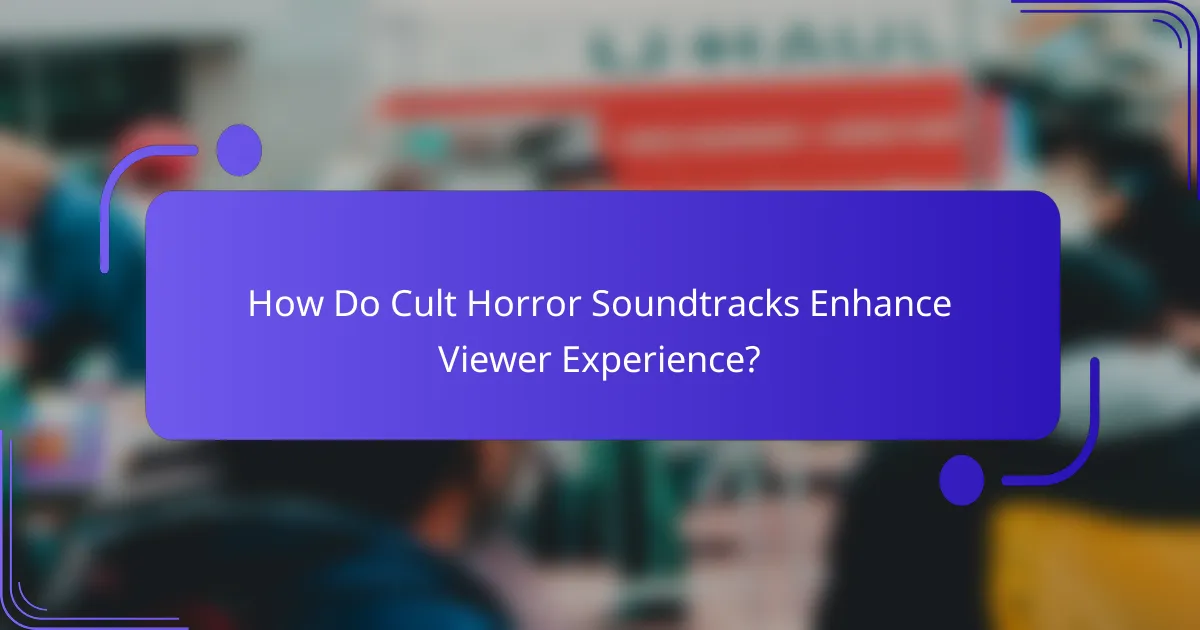
How Do Cult Horror Soundtracks Enhance Viewer Experience?
Cult horror soundtracks significantly enhance viewer experience by creating an immersive atmosphere that amplifies tension and emotional engagement. These carefully curated scores and songs evoke specific feelings and memories, making the viewing experience more impactful and memorable.
You can explore more about these impactful scores in cult horror movie soundtracks.
Creating Atmosphere and Tension
The right soundtrack can transform a scene, establishing a mood that heightens suspense and fear. For instance, the use of dissonant chords or eerie soundscapes can signal impending danger, keeping viewers on edge. Classic examples include the haunting strings in “Psycho” or the minimalist piano in “The Witch,” both of which effectively create an unsettling atmosphere.
When selecting music for a horror film, consider how different instruments and tempos can influence the audience’s emotional state. Slow, drawn-out notes may evoke dread, while sudden, sharp sounds can induce shock. Filmmakers often experiment with these elements to find the perfect balance that enhances the narrative.
Emotional Resonance with Characters
Soundtracks can deepen the audience’s connection to characters by reflecting their emotions and struggles. For instance, a character’s theme can evoke sympathy or fear, depending on the context. In “Halloween,” the iconic theme not only signifies Michael Myers but also instills a sense of dread whenever it plays.
To effectively use music for emotional resonance, filmmakers should align the score with character arcs. This alignment can help viewers understand motivations and empathize with characters, making their journeys more compelling. Consider how the music shifts as characters face challenges or confront their fears.
Memorable Scenes and Iconic Moments
Cult horror soundtracks often accompany scenes that become iconic, embedding themselves in popular culture. Think of the chilling theme from “Jaws,” which instantly evokes images of the lurking shark and has become synonymous with suspense in cinema. These memorable scores can elevate scenes from ordinary to unforgettable.
Creating iconic moments through music requires careful timing and placement. A well-timed crescendo can amplify a jump scare or a pivotal plot twist, leaving a lasting impression on the audience. Filmmakers should aim to integrate soundtracks seamlessly with visuals to enhance the overall impact of key scenes.
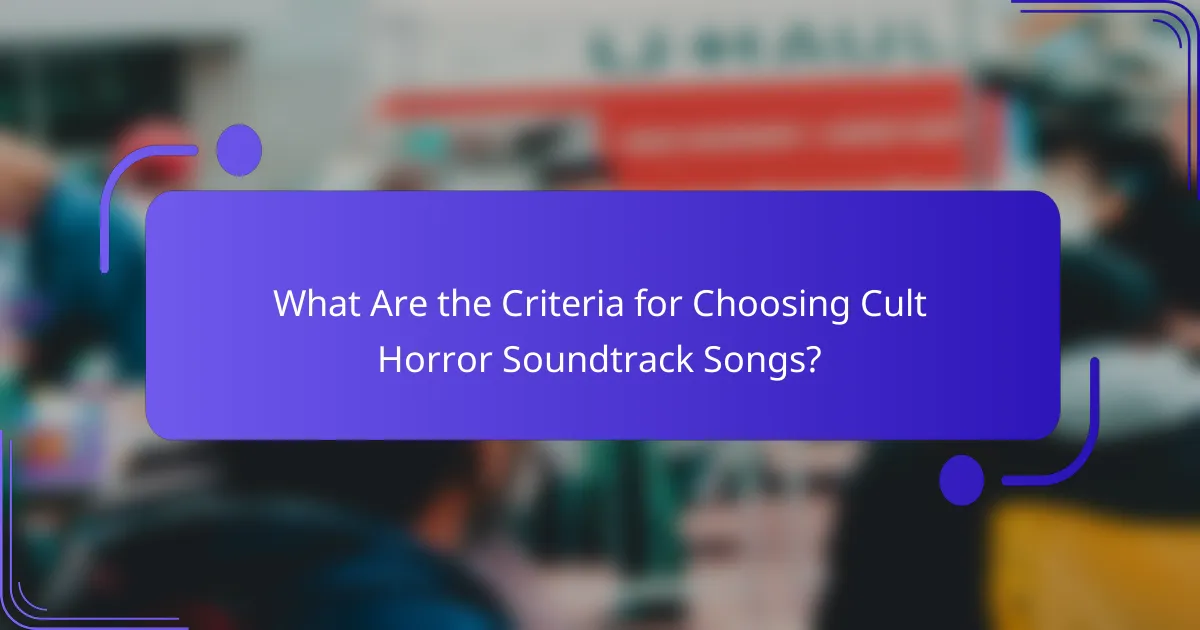
What Are the Criteria for Choosing Cult Horror Soundtrack Songs?
Choosing cult horror soundtrack songs involves assessing their popularity among fans, critical acclaim, and their lasting cultural impact. These criteria help identify tracks that resonate deeply with audiences and contribute significantly to the horror genre.
Popularity Among Fans
Fan popularity is a primary criterion for selecting cult horror soundtrack songs. Tracks that have garnered a strong following often become iconic, with listeners frequently revisiting them for their nostalgic or thrilling qualities. For example, songs from films like “Halloween” and “The Exorcist” have maintained a dedicated fan base over the years.
Social media platforms and streaming services can provide insights into which songs are trending among horror enthusiasts. Engaging with fan communities can also reveal which soundtracks are celebrated and frequently referenced in discussions.
Critical Acclaim and Awards
Critical acclaim plays a significant role in the selection of cult horror soundtrack songs. Soundtracks that receive accolades from music critics or industry awards often gain recognition that elevates their status. Notable examples include the scores from “Psycho” and “Get Out,” which have been praised for their innovative compositions and contributions to the films’ atmospheres.
Review aggregators and music publications can serve as valuable resources for identifying soundtracks that have received high praise. Awards such as the Grammy Awards for Best Score Soundtrack for Visual Media can also highlight noteworthy works in this genre.
Longevity and Cultural Relevance
Longevity and cultural relevance are essential factors in determining the status of cult horror soundtrack songs. Tracks that continue to be referenced or sampled in contemporary media demonstrate their lasting impact. For instance, the theme from “A Nightmare on Elm Street” remains a staple in pop culture, often appearing in various forms of media and events.
To assess a soundtrack’s cultural relevance, consider its presence in modern horror films, remixes, or even Halloween playlists. Songs that evoke strong emotional responses or memories from audiences tend to maintain their significance over time, further solidifying their cult status.
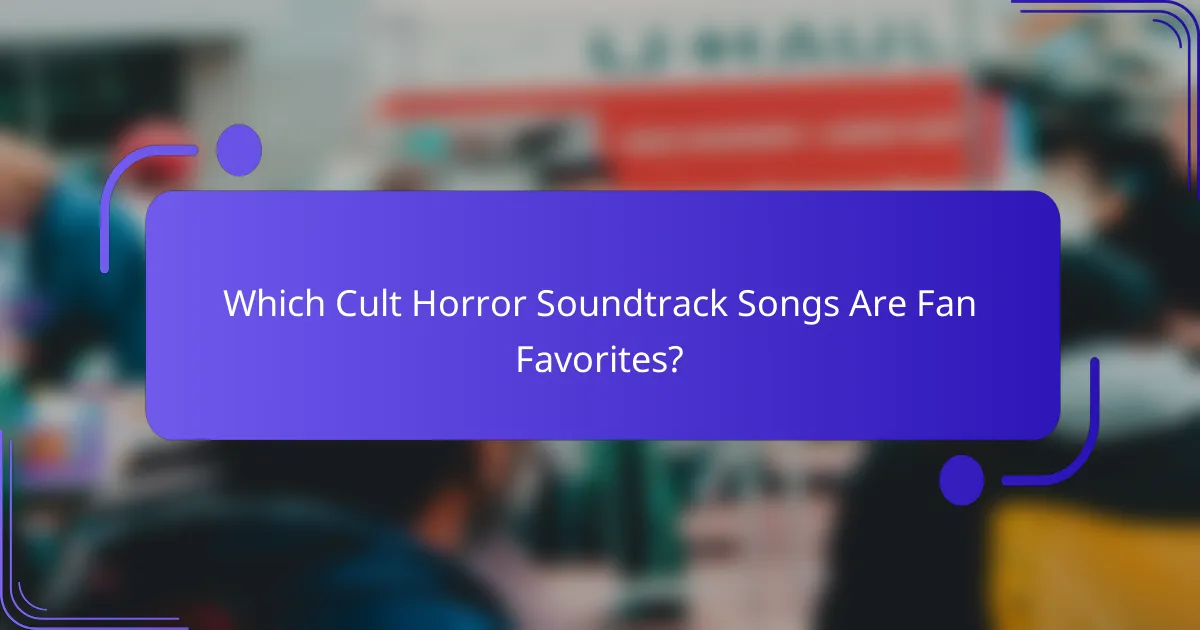
Which Cult Horror Soundtrack Songs Are Fan Favorites?
Fan-favorite cult horror soundtrack songs often blend memorable melodies with chilling themes, creating an unforgettable auditory experience. These tracks not only enhance the films they accompany but also resonate deeply with audiences, becoming iconic in their own right.
“Time Warp” from The Rocky Horror Picture Show
“Time Warp” is a standout track from the cult classic “The Rocky Horror Picture Show,” known for its catchy rhythm and interactive dance. This song invites audiences to participate, making it a staple at midnight screenings and Halloween events.
The song’s playful lyrics and infectious beat contribute to its lasting popularity, encouraging fans to embrace the campy spirit of the film. Its cultural significance is evident in the way it has inspired countless performances and themed parties worldwide.
“Welcome to My Nightmare” by Alice Cooper
“Welcome to My Nightmare” is a defining song by Alice Cooper that encapsulates the theatrical horror of his persona. Released in the mid-1970s, it combines rock with horror elements, making it a favorite among fans of both genres.
This track sets the tone for a chilling experience, blending eerie lyrics with a haunting melody. Its influence extends beyond music, as it has been featured in various horror-themed media, solidifying Cooper’s status as a pioneer in the horror rock genre.
“Zombie” by The Cranberries
The Cranberries’ “Zombie” is a powerful anthem that, while not a traditional horror song, evokes a sense of dread and urgency that resonates with horror fans. Its lyrics address themes of violence and conflict, making it a poignant addition to any horror soundtrack playlist.
This song’s haunting vocals and driving instrumentation create an atmosphere of tension, often associated with the horror genre. Its cultural impact is significant, as it has been used in various films and shows to underscore moments of fear and despair.
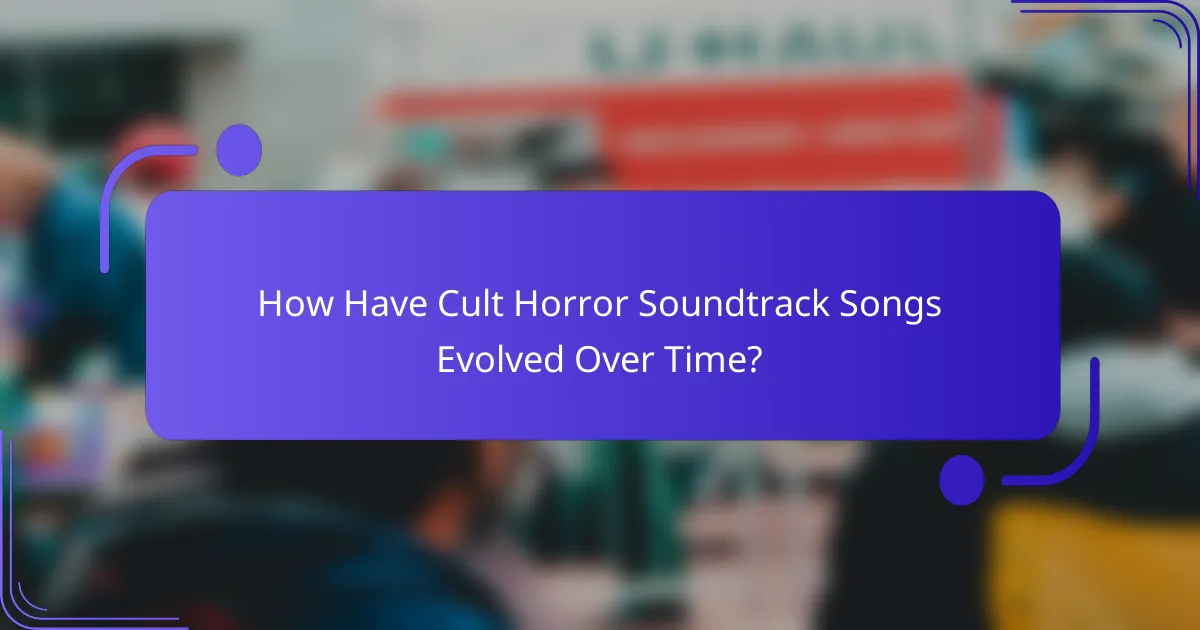
How Have Cult Horror Soundtrack Songs Evolved Over Time?
Cult horror soundtrack songs have transformed significantly, reflecting changes in musical styles, technology, and audience preferences. From the eerie orchestral scores of the early 20th century to the synth-heavy tracks of the 1980s and beyond, these soundtracks have adapted to enhance the horror experience.
Influence of Technology
The evolution of technology has played a crucial role in shaping cult horror soundtracks. Early films relied on live orchestras, while modern productions utilize digital audio workstations and synthesizers to create unique soundscapes. This shift allows for a broader range of sounds and effects, enhancing the emotional impact of horror films.
For example, the use of synthesizers in the 1980s led to iconic scores like John Carpenter’s “Halloween,” which defined the sound of slasher films. Today, filmmakers can experiment with sound design in ways that were previously impossible, creating immersive auditory experiences.
Cultural Shifts and Trends
Cult horror soundtracks have also evolved in response to cultural trends and societal fears. As horror films reflect contemporary anxieties, their soundtracks often incorporate elements that resonate with current audiences. For instance, the rise of electronic music in the 1990s and 2000s brought a new dimension to horror soundtracks, aligning with themes of technology and alienation.
Films like “The Blair Witch Project” and “It Follows” utilized minimalist scores that tapped into the psychological aspects of fear, showcasing how soundtracks can adapt to the narrative style and cultural context of their time.
Fan Favorites and Iconic Tracks
Certain cult horror soundtrack songs have achieved iconic status, becoming favorites among fans. Tracks like “Tubular Bells” from “The Exorcist” and “Halloween Theme” by John Carpenter are not only memorable but have also influenced countless other works in the genre. These songs often evoke a strong sense of nostalgia and are frequently referenced in popular culture.
Fans often celebrate these tracks through playlists, covers, and remixes, demonstrating their lasting impact. The continued popularity of vinyl records has also revived interest in collecting these soundtracks, allowing fans to experience the music in its original format.
